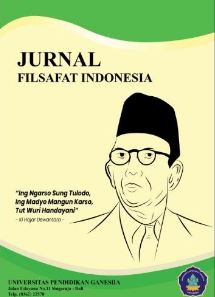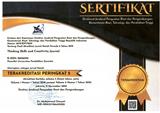Objektivikasi Subjek dalam Budaya Kontemporer berdasarkan Konsep Hiperrealitas Jean Baudrillard
DOI:
https://doi.org/10.23887/jfi.v6i3.59000Keywords:
subject, object, hyperreality, contemporary culture, mediaAbstract
This study aims to explain Jean Baudrillard's concept of hyperreality specifically the objectification of the subject in the context of contemporary culture. According to Jean Baudrillard, in the world of hyperreality which is controlled by the latest information and communication technology, humans have lost their subjectivity. The object has controlled the subject so that there is no other choice for the subject but to allow himself to be in the control of the object. The objectification character of this subject is evident in the subject's passivity when using the internet, being in front of the television, and also the advertising machine. According to Baudrillard, in the face of these three forms of contemporary culture, the subject has been reduced to an object so that the subjectivity and dimensions of the subject's consciousness become dead. The methodology used in this study is a qualitative method by conducting a literature study. The author specifically explores Jean Baudrillard's writings entitled “Simulacra and Simulation” (1981) which discusses a lot about the concept of hyperreality. The findings of this study are (1) subjects in contemporary culture have been reduced to objects through the simulation and simulacra skills of mass media technology, especially the internet, television, and advertising; (2) the objectification of this subject can be countered by re-realizing human subjectivity, namely the subject of consciousness.
References
Adlin, A (ed). (2016). Resistensi Gaya Hidup: Teori dan Realitas. Jalasutra.
Adlin, A. (2017). Spiritualitas dan Realitas Kebudayaan Kontemporer. Jalasutra.
Adon, M. J., Asman, A., & Masut, V. R. (2022). Konsep Filosofis Budaya Peler Manggarai dalam Terang Filsafat Dialogis Martin Buber. Jurnal Penelitian Sejarah dan Budaya, 8(2), 197-223.
Balibar, E. (2019). Citizen Subject. Fordham Journal, 3(8), 33-57.
Baudrillard, J. (2019). For a Critique of the Political Economy of the Sign. Verso Books.
Baudrillard, J. (1983). Simulation and Simulacra. Verso Books.
Baudrillard, J. (1989). America. Routledge.
Baudrillard, J. (1990). Fatal Strategis. Verso Books.
Bertens, K. (1999). Ringkasan Sejarah Filsafat. Kaision.
Bertens, K. (2006). Filsafat Barat Kontemporer Prancis. Gramedia.
Cempaka, P. S., & Haryatmoko, J. (2019). Hyperreality Among Defense of the Ancients 2’s Players. Jurnal Komunikasi Indonesia, 1(2), 225-234.
Donnel, K. (2019). Posmodernisme. Penerbit Kanisius.
Eco, U. (2017). Tamasya dalam Hiperealitas. Jalasutra.
Fitrianti, R. (2021). Simulacrum Media di Era Postmodern: Analisa Semiotika Jean Baudrillard dalam Narasi Iklan Kecantikan Dove Edisi ‘Dove Real Beauty Sketches’. Bureaucracy Journal: Indonesia Journal of Law and Social-Political Governance, 1(2), 92-117.
Hadi, A. (2022). Matinya Dunia Cyberspace Kritik Humanis Mark Slouka Terhadap Jagat Maya. LkiS.
Hamersma, H. (2012). Tokoh-Tokoh Filsafat Barat Modern. Gramedia.
Harari, Y. N. (2018). Homo Deus: Masa Depan Umat Manusia. Pustaka Alvabet.
Hardiman, F. B. (2007). Filsafat Modern dari Machiavelli sampai Nietzsche. Gramedia.
Husni, H., & Tantowie, T. A. J. (2017). Religion, Modernism and Postmodernism: Study on Jean Baudrillard’s Philosophy. Religious Studies: An International Journal, 5(2).
Ibrahim, I. S.(ed). (2018). Ecstasy Gaya Hidup Kebudayaan Pop dalam Masyarakat Komoditas Indonesia. Mizan Pustaka.
Imam, A. M. (2021). Galaksi Simulakra Esei-Esei Jean Baudrillard. LkiS.
Isbister, K. (2019). Toward ‘Suprahuman’Technology. In Proceedings of the Halfway to the Future Symposium 2019.
Jauhari, M. (2019). Media Sosial: Hiperrealitas dan Simulacra Perkembangan Masyarakat Zaman Now Dalam Pemikiran Jean Baudrillard. Al'Adalah, 20 (1).
Kasman, S. (2011). Komodifikasi Kesenian Tradisional Wacana Estetika Postmodern dalam Pariwisata. Ekspresi Seni: Jurnal Ilmu Pengetahuan dan Karya Seni, 13(2).
Kellner, D. (1999). Virilio, War, and technology: Some critical reflections. Theory, Culture & Society, 16(5-6), 103-125.
Lechte, J. (2001). 50 Filsuf Kontemporer “Dari Strukturalisme sampai Postmodernisme”. Yogyakarta: Kanisius.
Luke, T. W. (2021). Power and Politics in Hyperreality: The critical project of Jean Baudrillard. The Social Science Journal, 28(3), 347-367.
Maulina, P. (2018). Warung Kopi, Masyarakat Virtual, Dan Hiperealitas (Ketika Warung Kopi Mengaburkan Batasan Realita). Jurnal Ilmu Komunikasi, 4(1), 26-37.
Masduki, A. (2015). Mitos dan Hiperrealitas Komunikasi Politik (Studi Iklan Pemilu Jusuf Kalla-Wiranto Versi Humble dan Mampu). Informasi, 45(2), 125-140.
Masut, V. R., Barut, M. C. P. N., Muwa, F., & Budi, A. S. (2022). Tinjauan Gaudium Et Spes tentang Martabat Manusia dalam Kasus Terorisme. Jurnal Masalah Pastoral, 10(2), 93-103.
Nararya, R. R. W. D. K., & Laksana, R. C. M. (2022). Kajian Semiotik Jean Baudrillard Dalam Iklan Televisi Nestle Bear Brand. Askara: Jurnal Seni dan Desain, 1(1), 29-34.
Nugrahenny, T. T. (2018). Menyingkap Mekanisme Tanda di Balik Hiperrealitas Trend Hijab (Analisis Semiotika pada Fenomena Tren Hijab). Jurnal Komunikasi Indonesia, 16-28.
Nuraini, S., & Listiani, E. (2022). Hiperrealitas Kecantikan pada Drama Korea. In Bandung Conference Series: Communication Management (Vol. 2, No. 1).
Nurhalizah, S. N., & Jamilah, S. (2022). Hiperrealitas Simulakra Pengguna Instagram Mahasiswa Fakultas Ushuluddin Adab Dan Dakwah IAIN Parepare. Jourmics: Journal of Media and Communication Studies, 1(2), 67-90.
Oktavianingtyas, I., Seran, A., & Sigit, R. R. (2021). Jean Baudrillard dan Pokok Pemikirannya. Propaganda, 1(2), 113-121.
Pangaribuan, O. C., & Eriyanto, E. (2019). Hiperrealitas Jokowi Pada Video Opening Ceremony Asian Games 2018. Wacana: Jurnal Ilmiah Ilmu Komunikasi, 18(1), 87-100.
Permana, A. (2012). Gejala Alienasi dalam Masyarakat Konsumeristik. Jurnal Pemikiran Sosiologi, 1(2).
Piliang, Y. A. (2019). Hiperrealitas Kebudayaan, Penerbit LkiS.
Piliang, Y.A. (2018). Hipersemiotika Tafsir Cultural Studies Atas Matinya Makna. Jalasutra.
Piliang, Y. (2014). Dunia yang Dilipat “Tamasya Melampaui Batas-Batas Kebudayaan”. Jalasutra.
Ritter, G. (2015). Teori Sosiologi Modern. Kencana.
Rogers, F. M. (2019). Barbie Culture Ikon Budaya Konsumerisme. Relief.
Russell, B. (2002). Sejarah Filsafat Barat. Pustaka Pelajar.
Saeng, V. (2019). Antara Eureka dan Erica: Konsep Manusia di Era 4.0. Seri Filsafat Teologi, 29(28), 48-76.
Sardono, E. E., Masut, V. R., & Hagoldin, S. (2021). Relevansi Konsep Persekutuan Perikhoresis Allah Tritunggal Menurut Leonardo Boff Bagi Kehidupan Sosial-Politik. Jurnal Teologi, 10(2), 179-194.
Sari, N. I. (2020). Politik Simulacra dalam Ekstasi Media Sosial di Indonesia. Ad-Dariyah: Jurnal Dialektika, Sosial, dan Budaya, 1(1), 40-51.
Sarup, M. (2019). Postrukturalisme dan Posmodernisme: Sebuah Pengantar Kritis. Yogyakarta: Jendela.
Siswadi, G. A. (2022). Hiperrealitas di Media Sosial dalam Perspektif Simulakra Jean Baudrillard. Dharmasmrti: Jurnal Ilmu Agama dan Kebudayaan, 22(1), 9-18.
Striniti, D. (2019). Popular Culture Pengantar menuju Teori Budaya. Bentang.
Sugiharto, B. (2017). Postmodernisme Tantangan bagi Filsafat. Kanisius.
Wardhana, A. A. N. A. S. (2022). Hiperrealitas dalam Permainan Video Daring: Simulasi, Simulakra, dan Hiperrealitas Garena Free Fire. Perspektif, 11(2), 607-614.
Wolny, R. W. (2017). Hyperreality and Simulacrum: Jean Baudrillard and European Postmodernism. European Journal of Interdisciplinary Studies, 3(3), 75-79.
Downloads
Published
Issue
Section
License
Copyright (c) 2023 Jurnal Filsafat Indonesia

This work is licensed under a Creative Commons Attribution-ShareAlike 4.0 International License.

Jurnal Filsafat Indonesia Undiksha is licensed under a Creative Commons Attribution-ShareAlike 4.0 International License.




